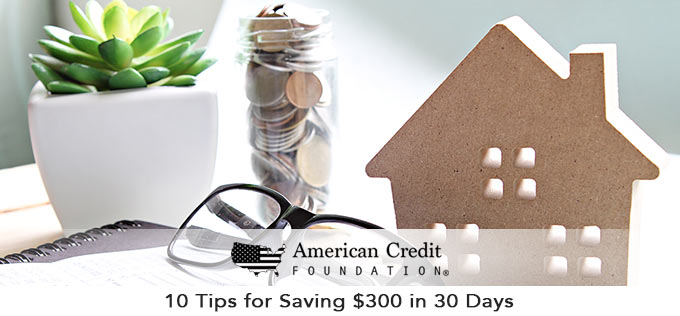10 Tips for Saving $300 in 30 Days

It’s not always easy to save money – especially if you’re trying to pay down credit card debt, live on a budget, and handle day-to-day expenses. But even when funds are tight, it’s definitely possible to stash away some extra cash. And you can even make it fun by challenging yourself to meet a specific savings goal.
Want to try it? How about saving $300 in 30 days? That sounds challenging, to be sure – but it can be done. The key to meeting the goal is a combination of saving money, reducing spending, and cutting back on bills and other expenses.
Ready to challenge yourself? Here are 10 ways to free up an extra $300 (or more!) this month:
- Skip drive-thru coffee and fast-food lunches. They seem like tiny expenses, but they can really add up over an entire month. If you buy a cup of $2 coffee on the way to work in the morning, you’re looking at $10 a week! And let’s say you spend $6 a day on a fast-food lunch – that’s $30 a week! Bring your own coffee and brown-bag it with leftovers from home – and put the extra money in the bank!
- Do an audit of all your bills. You may find a few places to cut costs on your monthly bills: Do you pay for more texting or data than you actually need? You might be able to switch to a less expensive cell phone plan. Do you really watch all 200 channels of premium cable TV? Do you have more car insurance than you need? You might be surprised at how much you can save by simply scaling back on your bills.
- Cut the cord(s). Why pay for a traditional landline telephone when you’ve got a working cell phone? And why pay for even basic cable when there are much more economical options out there like Hulu, Sling, or HBO Now?
- Cancel memberships and subscriptions you don’t need. Magazine subscriptions, unused gym memberships, monthly boxes of clothing, cosmetics, or snacks – if they’re not essential and/or you don’t use them, consider cutting them completely.
- Set up an automatic transfer from checking to savings. This is an especially good option if you have direct deposit. Simply set up an automatic, recurring transfer that will move a specified amount of money from your checking account to your savings account. Try something like $50 a paycheck. If you get paid twice a month, that’s an extra $100! Chances are, you’ll never even miss it!
- Sell stuff. From sports equipment and designer clothing to kitchen gadgets, toys, and more, if you’re not using it, sell it! Consider eBay, Craigslist, or a good old-fashioned garage sale.
- Find a “side hustle.” A side hustle can be almost anything, from a traditional part-time job at a retail store to something more flexible like pet sitting or driving for a ride-sharing service like Uber or Lyft.
- Do a one- or two-week spending freeze. Challenge yourself to go a week – or even two weeks – without making any unnecessary purchases. You can pay for essentials like groceries and gas, but nothing extra! You might be surprised at how much money you have left over.
- Trim your grocery budget. Do you think you could reduce your grocery spending by, say, $25 or even $50 per trip for the next month? Here are a few ways cut costs: Plan your meals, shop with a list, don’t buy prepackaged convenience foods, and skip the junk food aisle. Instead, stick to items like fresh or frozen veggies, dried beans, rice, and eggs – all cheap, filling, and healthy.

- Use the buddy system. Money challenges are always more fun with a friend. Ask around and see if any of your friends are interested in doing the “$300 in 30 days” challenge with you. Having a savings buddy will also help you stay motivated, so you’ll be less likely to quit before you’ve finished the challenge.
So, are you ready for the challenge? Saving $300 in 30 days might be easier than you think, especially if you use a few of the tips above. And who knows? Once you save $300, you might want to keep going and save $500 or even $1,000! And remember, the team at American Credit Foundation is always available to answer your questions about debt, credit, and budgeting.

